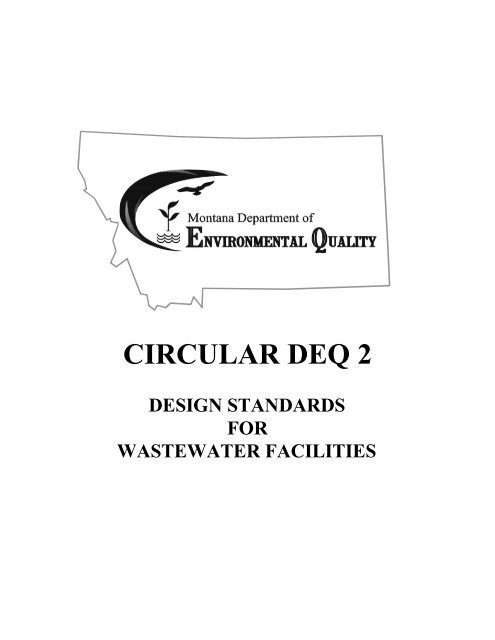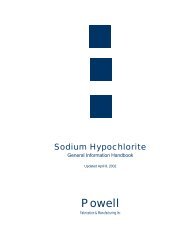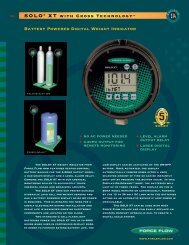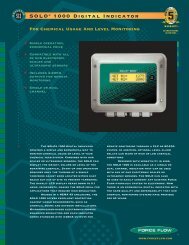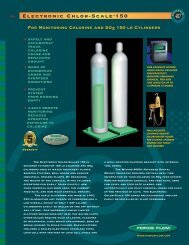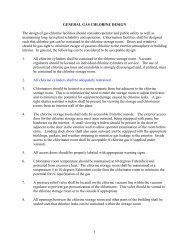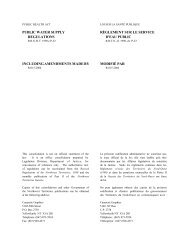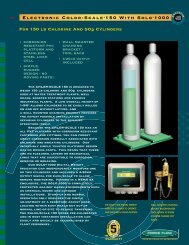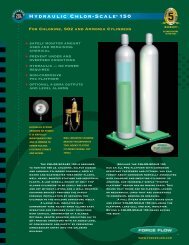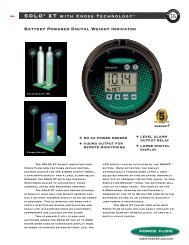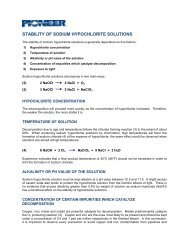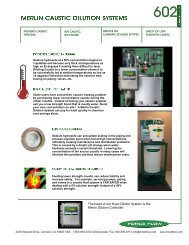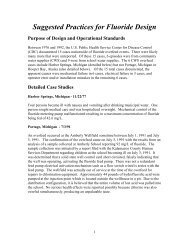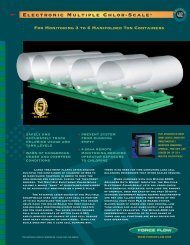Montana DEQ - Circular DEQ 2 - Design Standards for ... - Force Flow
Montana DEQ - Circular DEQ 2 - Design Standards for ... - Force Flow
Montana DEQ - Circular DEQ 2 - Design Standards for ... - Force Flow
Create successful ePaper yourself
Turn your PDF publications into a flip-book with our unique Google optimized e-Paper software.
CIRCULAR <strong>DEQ</strong> 2DESIGN STANDARDSFORWASTEWATER FACILITIES
CHAPTER 100DISINFECTION101. GENERALDisinfection of the effluent must be provided as necessary to meet applicable standards. Thedesign must meet both the bacterial standards and the disinfectant residual limit in theeffluent. The disinfection process should be selected after due consideration of wastecharacteristics, type of treatment process provided prior to disinfection, waste flow rates, pHof waste, disinfectant demand rates, current technology application, cost of equipment andchemicals, power cost, and maintenance requirements.Chlorine is the most commonly used chemical <strong>for</strong> wastewater disinfection. The <strong>for</strong>ms mostoften used are liquid chlorine and calcium or sodium hypochlorite. Other disinfectants,including chlorine dioxide, ozone, bromine, or ultraviolet disinfection, may be accepted bythe approving authority in individual cases. If halogens are utilized, it may be necessary todehalogenate if the residual level in the effluent exceeds effluent limitations or would impairthe natural aquatic habitat of the receiving stream.Municipalities are encouraged to investigate the use of U.V. disinfection due to safety andtoxicity benefits.Where a disinfection process other than chlorine is proposed, supporting data from pilotplant installations or similar full scale installations may be required as a basis <strong>for</strong> the designof the system.102. CHLORINE DISINFECTION102.1 TypeChlorine is available <strong>for</strong> disinfection in gas, liquid (hypochlorite solution), andpellet (hypochlorite tablet) <strong>for</strong>m. The type of chlorine should be carefully evaluatedduring the facility planning process. The use of chlorine gas or liquid will be mostdependent on the size of the facility and the chlorine dose required. Large quantitiesof chlorine, such as are contained in ton cylinders and tank cars, can present aconsiderable hazard to plant personnel and to the surrounding area, should suchcontainers develop leaks. Both monetary costs and the potential public exposure tochlorine should be considered when making the final determination.143
Chapter 100Disinfection102.2 DosageFor disinfection, the capacity must be adequate to produce an effluent that will meetthe coli<strong>for</strong>m limits specified by the regulatory agency <strong>for</strong> that installation. Requireddisinfection capacity will vary, depending on the uses and points of application ofthe disinfection chemical. The chlorination system must be designed on a rationalbasis and calculations justifying the equipment sizing and number of units must besubmitted <strong>for</strong> the whole operating range of flow rates <strong>for</strong> the type of control to beused. System design considerations must include the controlling wastewater flowmeter (sensitivity and location), telemetering equipment and chlorination controls.For normal domestic sewage, the following may be used as a guide in sizingchlorination facilities:Type of TreatmentDosage102.3 ContainersTrickling filter plant effluent10 mg/LActivated sludge plant effluent 8 mg/LTertiary filtration effluent 6 mg/LNitrified effluent 6 mg/L102.31 Cylinders150 pound (68 kg) cylinders are typically used where chlorine gasconsumption is less than 150 pounds per day (68 kg/day). Cylinders shouldbe stored in an upright position with adequate support brackets and chainsat 2/3 of cylinder height <strong>for</strong> each cylinder.102.32 Ton ContainersThe use of one-ton (909 kg) containers should be considered where theaverage daily chlorine consumption is over 150 pounds (68 kg).102.33 Liquid Hypochlorite SolutionsStorage containers <strong>for</strong> hypochlorite solutions must be of sturdy, nonmetalliclined construction and must be provided with secure tank tops andpressure relief and overflow piping. Storage tanks should be either locatedor vented outside. Provision must be made <strong>for</strong> adequate protection fromlight and extreme temperatures. Tanks must be located where leakage willnot cause corrosion or damage to other equipment. A means of secondarycontainment must be provided to contain spills and facilitate cleanup. Dueto deterioration of hypochlorite solutions over time, it is recommended thatcontainers not be sized to hold more than one month's needs. At largerfacilities and locations where delivery is not a problem, it may be desirableto limit on-site storage to one week. Refer to Section 57.144
Disinfection Chapter 100102.34 Dry Hypochlorite Compounds102.4 Equipment102.41 ScalesDry hypochlorite compounds should be kept in tightly closed containers andstored in a cool, dry location. Some means of dust control should beconsidered, depending on the size of the facility and the quantity ofcompound used. Refer to Section 57.Scales <strong>for</strong> weighing cylinders must be provided at all plants using chlorinegas. At large plants, scales of the indicating and recording type arerecommended. At least a plat<strong>for</strong>m scale must be provided. Scales must beof corrosion-resistant material.102.42 EvaporatorsWhere manifolding of several cylinders or ton containers will be required toevaporate sufficient chlorine, consideration should be given to theinstallation of evaporators to produce the quantity of gas required.102.43 MixingThe disinfectant must be positively mixed as rapidly as possible, with acomplete mix being effected in 3 seconds. This may be accomplished byeither the use of turbulent flow regime or a mechanical flash mixer.102.44 Contact Period and TankFor a chlorination system, a minimum contact period of 15 minutes atdesign peak hourly flow or maximum rate of pumpage must be providedafter thorough mixing. For evaluation of existing chlorine contact tanks,field tracer studies should be done to assure adequate contact time.The chlorine contact tank must be constructed so as to reduce shortcircuitingof flow to a practical minimum. Tanks not provided withcontinuous mixing must be provided with "over-and-under" or "endaround"baffling to minimize short-circuiting.The tank should be designed to facilitate maintenance and cleaning withoutreducing effectiveness of disinfection. Duplicate tanks, mechanicalscrapers, or portable deck-level vacuum cleaning equipment must beprovided. Consideration should be given to providing skimming devices onall contact tanks. Covered tanks are discouraged.145
Chapter 100Disinfection102.45 Piping and ConnectionsPiping systems should be as simple as possible, specifically selected andmanufactured to be suitable <strong>for</strong> chlorine service, with a minimum number ofjoints. Piping should be well supported and protected against temperatureextremes.Due to the corrosiveness of wet chlorine, all lines designated to handle drychlorine must be protected from the entrance of water or air containingwater. Even minute traces of water added to chlorine results in a corrosiveattack. Low pressure lines made of hard rubber, saran-lined, rubber-lined,polyethylene, polyvinylchloride (PVC), or other approved materials aresatisfactory <strong>for</strong> wet chlorine or aqueous solutions of chlorine.102.46 Standby Equipment and Spare PartsStandby equipment of sufficient capacity should be available to replace thelargest unit during shutdowns. Spare parts must be available <strong>for</strong> alldisinfection equipment to replace parts that are subject to wear andbreakage.102.47 Chlorinator Water SupplyAn ample supply of water must be available <strong>for</strong> operating the chlorinator.Where a booster pump is required, duplicate equipment should be provided,and, when necessary, standby power as well. Protection of a potable watersupply must con<strong>for</strong>m to the requirements of Section 56.2. Adequatelyfiltered plant effluent should be considered <strong>for</strong> use in the chlorinator.102.48 Leak Detection and ControlsA bottle of 56 percent ammonium hydroxide solution must be available <strong>for</strong>detecting chlorine leaks. Where ton containers (909 kg) or tank cars areused, a leak repair kit approved by the Chlorine Institute must be provided.Consideration should be given to the provision of caustic soda solutionreaction tanks <strong>for</strong> absorbing the contents of leaking one-ton (909 kg)containers where such containers are in use. At large chlorinationinstallations, consideration should be given to the installation of automaticgas detection and related alarm equipment.146
Disinfection Chapter 100102.5 Housing102.51 Feed and Storage RoomsIf gas chlorination equipment or chlorine cylinders are to be in a buildingused <strong>for</strong> other purposes, a gas-tight room must separate this equipmentfrom any other portion of the building. Floor drains from the chlorine roommay not be connected to floor drains from other rooms. Doors to this roommay open only to the outside of the building, and must be equipped withpanic hardware. Chlorine rooms must be at ground level, and should permiteasy access to all equipment. Storage areas <strong>for</strong> 1-ton (909 kg) cylindersshould be separated from the feed area. In addition, the storage area musthave designated areas <strong>for</strong> "full" and "empty" cylinders. Chlorinationequipment should be situated as close to the application point as reasonablypossible. For additional safety considerations, refer to Section 57.102.52 Inspection Window102.53 HeatA clear glass, gas-tight, window must be installed in an exterior door orinterior wall of the chlorinator room to permit the units to be viewedwithout entering the room.Rooms containing disinfection equipment must be provided with a meansof heating so that a temperature of at least 60F (16C) can bemaintained. The room should be protected from excess heat. Cylindersmust be kept at essentially room temperature.102.54 Ventilation and Accidenta l ReleaseWith chlorination systems, <strong>for</strong>ced, mechanical ventilation must be installedthat will provide one complete air change per minute when the room isoccupied. The entrance to the air exhaust duct from the room must be nearthe floor and the point of discharge must be located so as not tocontaminate the air inlet to any buildings or inhabited areas. Air inlets mustbe located so as to provide cross ventilation with air and at suchtemperature that will not adversely affect the chlorination equipment. Theoutside air inlet must be at least three feet above grade. The vent hose fromthe chlorinator must discharge to the outside atmosphere above grade.Where public exposure may be extensive, scrubbers may be required onventilation discharge.See the Uni<strong>for</strong>m Fire Code requirements <strong>for</strong> treatment of gases as:Treatment systems may be necessary to handle the accidental release of gas.Treatment systems may be necessary to process all exhaust ventilation to bedischarged from gas cabinets, exhausted enclosures or separate gas storagerooms.147
Chapter 100Disinfection102.55 Electrical ControlsSwitches <strong>for</strong> fans and lights must be outside of the room at the entrance. Alabeled signal light indicating fan operation must be provided at eachentrance, if the fan can be controlled from more than one point.102.56 Protective and Respiratory Gear102.6 Sampling and ControlRespiratory air-pac protection equipment, meeting the requirements of theNational Institute <strong>for</strong> Occupational Safety and Health (NIOSH), must beavailable where chlorine gas is handled, and must be stored at a convenientlocation, but not inside any room where chlorine is used or stored.Instructions <strong>for</strong> using the equipment must be posted. The units must usecompressed air, have at least 30-minute capacity and be compatible withthe units used by the fire department responsible <strong>for</strong> the plant.102.61 SamplingFacilities must be included <strong>for</strong> sampling disinfected effluent after contact.In large installations, or where stream conditions warrant, provisions shouldbe made <strong>for</strong> continuous monitoring of effluent chlorine residual.102.62 Testing and Control103. DECHLORINATION103.1 TypesEquipment must be provided <strong>for</strong> measuring chlorine residual using acceptedtest procedures. The installation of demonstrated effective facilities <strong>for</strong>automatic chlorine residual analysis, recording, and proportioning systemsshould be considered at all large installations.Equipment must also be provided <strong>for</strong> measuring fecal coli<strong>for</strong>m organisms,using accepted test procedures as required by the regulatory agency.Dechlorination of wastewater effluent may be necessary to reduce the toxicity due tochlorine residuals. The most common dechlorination chemicals are sulfurcompounds, particularly sulfur dioxide gas or aqueous solutions of sulfite orbisulfite. Pellet dechlorination systems are also available <strong>for</strong> small facilities.The type of dechlorination system should be carefully selected considering criteriaincluding the following: type of chemical storage required, amount of chemicalneeded, ease of operation, compatibility with existing equipment, and safety.103.2 Dosage148
Disinfection Chapter 100The dosage of dechlorination chemical should depend on the residual chlorine in theeffluent, the final residual chlorine limit, and the particular <strong>for</strong>m of thedechlorinating chemical used. The most common dechlorinating agent is sulfite.The following <strong>for</strong>ms of the compound are commonly used and yield sulfite (SO 2 )when dissolved in water.Dechlorination Chemical Theoretical mg/L Required to Neutralize 1 mg/L Cl 2Sulfur dioxide (gas) 0.9Sodium meta bisulfite (solution) 1.34Sodium bisulfite (solution) 1.46Theoretical values may be used <strong>for</strong> initial approximations, to size feed equipmentwith the consideration that under good mixing conditions 10% excess dechlorinatingchemical is required above theoretical values. Excess sulfur dioxide may consumeoxygen at a maximum of 1.0 mg dissolved oxygen <strong>for</strong> every 4 mg SO 2 .The liquid solutions come in various strengths. These solutions may need to befurther diluted to provide the proper dose of sulfite.103.3 ContainersDepending on the chemical selected <strong>for</strong> dechlorination, the storage containers willvary from gas cylinders, liquid in 50 gallon (190 L) drums or dry compounds.Dilution tanks and mixing tanks will be necessary when using dry compounds andmay be necessary when using liquid compounds to deliver the proper dosage.Solution containers should be covered to prevent evaporation and spills.103.4 Feed Equipment, Mixing, and Contact Requirements103.41 EquipmentIn general, the same type of feeding equipment used <strong>for</strong> chlorine gas may beused with minor modifications <strong>for</strong> sulfur dioxide gas. However, themanufacturer should be contacted <strong>for</strong> specific equipment recommendations.No equipment should be alternately used <strong>for</strong> the two gases. The commontype of dechlorination feed equipment utilizing sulfur compounds includevacuum solution feed of sulfur dioxide gas and a positive displacementpump <strong>for</strong> aqueous solutions of sulfite or bisulfite.149
Chapter 100DisinfectionThe selection of the type of feed equipment utilizing sulfur compoundsmust include consideration of the operator safety and overall public safetyrelative to the wastewater treatment plant's proximity to populated areasand the security of gas cylinder storage. The selection and design of sulfurdioxide feeding equipment must take into account that the gas reliquifiesquite easily. Special precautions must be taken when using ton (909 kg)containers to prevent reliquification.Where necessary to meet the operating ranges, multiple units must beprovided <strong>for</strong> adequate peak capacity and to provide a sufficiently low feedrate on turn down to avoid depletion of the dissolved oxygen concentrationsin the receiving waters.103.42 Mixing RequirementsThe dechlorination reaction with free or combined chlorine will generallyoccur within 15-20 seconds. Mechanical mixers are required unless themixing facility will provide the required hydraulic turbulence to assurethorough and complete mixing. The high solubility of SO 2 prevents it fromescaping during turbulence.103.43 Contact TimeA minimum of 30 seconds <strong>for</strong> mixing and contact time must be provided atthe design peak hourly flow or maximum rate of pumpage. A suitablesampling point must be provided downstream of the contact zone.Consideration must be given to a means of reaeration to assure maintenanceof an acceptable dissolved oxygen concentration in the stream followingsulfonation.103.44 Standby Equipment and Spare PartsThe same requirements apply as <strong>for</strong> chlorination systems. See Section102.46.103.45 Sulfonator Water SupplyThe same requirements apply as <strong>for</strong> chlorination systems. See Section102.47.150
Disinfection Chapter 100103.5 Housing Requirements103.51 Feed and Storage RoomsThe requirements <strong>for</strong> housing SO 2 gas equipment should follow the sameguidelines as used <strong>for</strong> chlorine gas. Refer to Section 102.5 <strong>for</strong> specificdetails.When using solutions of the dechlorinating compounds, the solutions maybe stored in a room that meets the safety and handling requirements set<strong>for</strong>th in Section 57. The mixing, storage, and solution delivery areas mustbe designed to contain or route solution spillage or leakage away fromtraffic areas to an appropriate containment unit.103.52 Protective and Respiratory Gear103.6 Sampling and ControlThe respiratory air-pac protection equipment is the same as <strong>for</strong> chlorine.See Section 102.56. Leak repair kits of the type used <strong>for</strong> chlorine gas thatare equipped with gasket material suitable <strong>for</strong> service with sulfur dioxidegas may be used. (Refer to The Compressed Gas Association PublicationCGA G-3-1988, "Sulfur Dioxide.") For additional safety considerations,see Section 57.103.61 SamplingFacilities must be included <strong>for</strong> sampling the dechlorinated effluent <strong>for</strong>residual chlorine. Provisions must be made to monitor <strong>for</strong> dissolved oxygenconcentration after sulfonation when required by the regulatory agency.103.62 Testing and ControlProvision must be made <strong>for</strong> manual or automatic control of sulfonator feedrates based on chlorine residual measurement or flow.104. ULTRAVIOLET RADIATION DISINFECTION<strong>Design</strong> standards, operating data, and experience <strong>for</strong> this process are not well established.There<strong>for</strong>e, expected per<strong>for</strong>mance of the ultraviolet radiation disinfection (UVRD) units mustbe based upon experience at similar full scale installations or thoroughly documentedprototype testing with the particular wastewater. Critical parameters <strong>for</strong> UVRD units aredependent upon the manufacturers' design, lamp selection, tube materials, ballasts,configuration, control systems, and associated appurtenances. Proposals on this disinfectionprocess will be reviewed on a case-by-case basis at the discretion of the reviewing authorityunder Section 53.2.151
Chapter 100DisinfectionOpen channel designs with modular UVRD units that can be removed from the flow arerequired. At least two banks in series must be provided in each channel <strong>for</strong> disinfectionreliability and to ensure uninterrupted service during tube cleaning or other requiredmaintenance. Operator safety and tube cleaning frequency must also be considered. Thehydraulic properties of the system must be designed to simulate plug flow conditions underthe full operating flow range. In addition, a positive means of water level control must beprovided to achieve the necessary exposure time. Also refer to paragraphs 54.2 and 54.3.This process should be limited to high quality effluent having at least 65% ultravioletradiation transmittance at 254 nanometers wave length. As a general guide in systems sizing<strong>for</strong> an activated sludge effluent with the preceding characteristics at the design peak hourlyflow, a UV radiation dosage of at least 30,000 uWsec/cm 2 may be used after adjustments <strong>for</strong>maximum tube fouling, lamp output reduction after 8760 hours of operation, and otherenergy absorption losses.105. OZONEOzone systems <strong>for</strong> disinfection should be evaluated on a case-by-case basis. <strong>Design</strong>standards, operating data, and experience <strong>for</strong> this process are not well established.There<strong>for</strong>e, design of these systems should be based upon experience at similar full scaleinstallations or thoroughly documented prototype testing with the particular wastewater.152
CHAPTER 110SUPPLEMENTAL TREATMENT PROCESSES111. PHOSPHORUS REMOVAL BY CHEMICAL TREATMENT111.1 General111.11 MethodAddition of lime or the salts of aluminum or iron may be used <strong>for</strong> thechemical removal of soluble phosphorus. The phosphorus reacts with thecalcium, aluminum or iron ions to <strong>for</strong>m insoluble compounds. Theseinsoluble compounds may be flocculated with or without the addition of acoagulant aid such as a polyelectrolyte to facilitate separation bysedimentation.111.12 <strong>Design</strong> Basis111.2 Process Requirements111.21 Dosage111.121 Preliminary TestingLaboratory, pilot or full scale studies of various chemicalfeed systems and treatment processes are recommended <strong>for</strong>existing plant facilities to determine the achievableper<strong>for</strong>mance level, cost-effective design criteria, andranges of required chemical dosages.The selection of a treatment process and chemical dosage<strong>for</strong> a new facility should be based on such factors asinfluent wastewater characteristics, effluent requirements,and anticipated treatment efficiency.111.122 System FlexibilitySystems must be designed with sufficient flexibility toallow <strong>for</strong> several operational adjustments in chemical feedlocation, chemical feed rates, and <strong>for</strong> feeding alternatechemical compounds.The design chemical dosage must include the amount needed to react withthe phosphorus in the wastewater, the amount required to drive the chemicalreaction to the desired state of completion, and the amount required due toinefficiencies in mixing or dispersion. Excessive chemical dosage shouldbe avoided.153
Chapter 110Supplemental Treatment Process111.22 Chemical SelectionThe choice of lime or the salts of aluminum or iron should be based on thewastewater characteristics and the economics of the total system. Whenlime is used, it may be necessary to neutralize the high pH prior tosubsequent treatment in secondary biological systems or prior to dischargein those flow schemes where lime treatment is the final step in the treatmentprocess.111.23 Chemical Feed PointsSelection of chemical feed points must include consideration of thechemicals used in the process, necessary reaction times between chemicaland polyelectrolyte additions, and the wastewater treatment processes andcomponents utilized. Flexibility in feed locations must be provided tooptimize chemical usage.111.24 Flash MixingEach chemical must be mixed rapidly and uni<strong>for</strong>mly with the flow stream.Where separate mixing basins are provided, they should be equipped withmechanical mixing devices. The detention period should be at least 30seconds.111.25 FlocculationThe particle size of the precipitate <strong>for</strong>med by chemical treatment may bevery small. Consideration should be given in the process design to theaddition of synthetic polyelectrolytes to aid settling. The flocculationequipment should be adjustable in order to obtain optimum floc growth,control deposition of solids, and prevent floc destruction.111.26 Liquid - Solids SeparationThe velocity through pipes or conduits from flocculation basins to settlingbasins should not exceed 1.5 feet per second (0.46 m/s) in order tominimize floc destruction. Entrance works to settling basins should also bedesigned to minimize floc shear.Settling basins must be designed in accordance with Chapter 70. Fordesign of the sludge handling system, special consideration should be givento the type and volume of sludge generated in the phosphorus removalprocess.111.27 FiltrationEffluent filtration must be considered where effluent phosphorusconcentrations of less than 1 mg/l must be achieved.154
Supplemental Treatment Process Chapter 110111.3 Feed Systems111.31 LocationAll liquid chemical mixing and feed installations should be installed oncorrosion resistant pedestals and elevated above the highest liquid levelanticipated during emergency conditions. The chemical feed equipmentmust be designed to meet the maximum dosage requirements <strong>for</strong> the designconditions. Lime feed equipment should be located so as to minimize thelength of slurry conduits. All slurry conduits must be accessible <strong>for</strong>cleaning.111.32 Liquid Chemical Feed SystemLiquid chemical feed pumps should be of the positive displacement typewith variable feed rate. Pumps must be selected to feed the full range ofchemical quantities required <strong>for</strong> the phosphorus mass loading conditionsanticipated with the largest unit out of service. Consideration should begiven to systems including pumps and piping that will feed either ferric oraluminum compounds to provide flexibility. Refer to Section 111.51.Screens and valves must be provided on the chemical feed pump suctionlines.An air break or anti-siphon device must be provided where the chemicalsolution stream discharges to the transport water stream to prevent aninduction effect resulting in overfeed.Consideration must be given to providing pacing equipment to optimizechemical feed rates.111.33 Dry Chemical Feed SystemEach dry chemical feeder must be equipped with a dissolver that is capableof providing a minimum 5-minute retention at the maximum feed rate.Polyelectrolyte feed installations should be equipped with two solutionvessels and transfer piping <strong>for</strong> solution make-up and daily operation.Make-up tanks must be provided with an educator funnel or otherappropriate arrangement <strong>for</strong> wetting the polymer during the preparation ofthe stock feed solution. Adequate mixing should be provided by a largediameter,low-speed mixer.155
Chapter 110Supplemental Treatment Process111.4 Storage Facilities111.41 SizeStorage facilities must be sufficient to insure that an adequate supply of thechemical is available at all times. Exact size required will depend on size ofshipment, length of delivery time, and process requirements. Storage <strong>for</strong> aminimum of 10-days' supply should be provided.111.42 Location and ContainmentThe liquid chemical storage tank and tank fill connections must be locatedwithin a containment structure having a capacity exceeding the total volumeof all storage vessels. Valves on discharge lines must be located adjacent tothe storage tank and within the containment structure. Refer to Section57.2. Auxiliary facilities, including pumps and controls, within thecontainment area must be located above the highest anticipated liquid level.Containment areas must be sloped to a sump area and may not containfloor drains.Bag storage should be located near the solution make-up point to avoidunnecessary transportation and housekeeping problems.111.43 Accessories111.5 Other RequirementsPlat<strong>for</strong>ms, stairs, and railings should be provided as necessary, to af<strong>for</strong>dconvenient and safe access to all filling connections, storage tank entries,and measuring devices.Storage tanks must have reasonable access provided to facilitate cleaning.111.51 MaterialsAll chemical feed equipment and storage facilities must be constructed ofmaterials resistant to chemical attack by all chemicals normally used <strong>for</strong>phosphorus removal. Refer to Section 57.111.52 Temperature, Humidity, and Dust ControlPrecautions must be taken to prevent chemical storage tanks and feed linesfrom reaching temperatures likely to result in freezing or chemicalcrystallization at the concentration employed. A heated enclosure orinsulation may be required. Consideration should be given to temperature,humidity, and dust control in all chemical feed room areas.156
Supplemental Treatment Process Chapter 110111.53 CleaningConsideration must be given to the accessibility of piping. Piping shouldbe installed with plugged wyes, tees or crosses with removable plugs atchanges in direction to facilitate cleaning.111.54 Filling Drains and Draw-offAbove-bottom draw off from chemical storage or feed tanks must beprovided to avoid withdrawal of settled solids into the feed system. Abottom drain must also be installed <strong>for</strong> periodic removal of accumulatedsettled solids. Provisions must be made in the fill lines to prevent backsiphonage of chemical tank contents.111.6 Safety and Hazardous Chemical HandlingThe Chemical handling facilities must meet the appropriate safety and hazardoushandling facilities requirements of Section 57.111.7 Sludge HandlingConsideration must be given to the type and additional capacity of the sludgehandling facilities needed when chemicals are added. <strong>Design</strong> of dewatering systemsshould be based, where possible, on an analysis of the characteristics of the sludgeto be handled. Consideration should be given to the ease of operation, effect ofrecycle streams generated, production rate, moisture content, dewaterability, finaldisposal, and operating costs. Refer to Chapter 80.112. HIGH RATE EFFLUENT FILTRATION112.1 General112.11 ApplicabilityGranular media filters may be used as an advanced treatment device <strong>for</strong> theremoval of residual suspended solids from secondary effluents. Filters maybe necessary where effluent concentrations of less than 20 mg/L ofsuspended solids and/or 1.0 mg/L of phosphorus must be achieved. A pretreatmentprocess such as chemical coagulation and sedimentation or otheracceptable process should precede the filter units where effluent suspendedsolids requirements are less than 10 mg/L.157
Chapter 110Supplemental Treatment Process112.12 <strong>Design</strong> Considerations112.2 Filter TypesCare should be given in designing pipes or conduits ahead of filter units, ifapplicable, to minimize shearing of floc particles. Consideration should begiven in the plant design to providing flow-equalization facilities tomoderate filter influent quality and quantity.Filters may be of the gravity type or pressure type. Pressure filters must beprovided with ready and convenient access to the media <strong>for</strong> inspection or cleaning.Where abnormal quantities of greases or similar solids, which result in filterplugging are expected, filters should be of the gravity type.112.3 Filtration Rates112.31 Allowable RatesFiltration rates may not exceed 5 gpm/sq. ft. (3.40 l/m 2 s) based on thedesign peak hourly flow rate applied to the filter units. The expected designmaximum suspended solids loading to the filter should also be consideredin determining the necessary filter area.112.32 Number of Units112.4 BackwashTotal filter area must be provided in two or more units, and the filtrationrate must be calculated based on the total available filter area with one unitout of service.112.41 Backwash RateThe backwash rate must be adequate to fluidize and expand each medialayer a minimum of 20 percent based on the media selected. The backwashsystem must be capable of providing variable backwash rates. Minimumand maximum backwash rates must be based on demonstrated satisfactoryfield experience under similar conditions. The design must provide <strong>for</strong> abackwash period of at least 10 minutes.112.42 Backwash PumpsPumps <strong>for</strong> back-washing filter units must be sized and interconnected toprovide the required backwash rate to any filter with the largest pump outof service. Filtered water from the clear well or chlorine tank must be usedas the source of backwash water. Waste filter backwash must beadequately treated.158
Supplemental Treatment Process Chapter 110112.43 Backwash Surge ControlThe rate of return of waste filter backwash water to treatment units must becontrolled so that the rate does not exceed 15 percent of the design averagedaily flow rate to the treatment unit. The hydraulic and organic load fromwaste backwash water must be considered in the overall design of thetreatment plant. Surge tanks must have a capacity of at least two backwashvolumes, although additional capacity should be considered to allow <strong>for</strong>operational flexibility. Where waste backwash water is returned <strong>for</strong>treatment by pumping, adequate pumping capacity must be provided withthe largest unit out of service.112.44 Backwash Water Storage112.5 Filter Media SelectionTotal backwash water storage capacity provided in an effluent clearwell orother unit must equal or exceed the volume required <strong>for</strong> two completebackwash cycles.Selection of proper media type and size will depend on required effluent quality, thetype of treatment provided prior to filtration, the filtration rate selected, and filterconfiguration. In dual or multi-media filters, media size selection must considercompatibility among media. Media must be selected and provided to meet specificconditions and requirements relative to the project under consideration. Theselection and sizing of the media must be based on demonstrated satisfactory fieldexperience under similar conditions. All media must have a uni<strong>for</strong>mity coefficientof 1.7 or less. The uni<strong>for</strong>mity coefficient, effective size, depth, and type of mediamust be set <strong>for</strong>th in the specifications.112.6 Filter AppurtenancesThe filters must be equipped with wash-water troughs, surface wash or air scouringequipment, means of measurement and positive control of the backwash rate,equipment <strong>for</strong> measuring filter head loss, positive means of shutting off flow to afilter being backwashed, and filter influent and effluent sampling points. Ifautomatic controls are provided, there must be a manual override <strong>for</strong> operatingequipment, including each individual valve essential to the filter operation. Theunderdrain system must be designed <strong>for</strong> uni<strong>for</strong>m distribution of backwash water(and air, if provided) without danger of clogging from solids in the backwash water.If air is to be used <strong>for</strong> filter backwash, separate backwash blower(s) must beprovided. Provision must be made to allow periodic chlorination of the filterinfluent or backwash water to control slime growths. When chemical disinfection isnot provided at the plant, manual dosage of chlorine compounds is acceptable.159
Chapter 110Supplemental Treatment Process112.7 Access and HousingEach filter unit must be designed and installed so that there is ready and convenientaccess to all components and the media surface <strong>for</strong> inspection and maintenancewithout taking other units out of service. Housing <strong>for</strong> filter units must be provided.The housing must be constructed of suitable corrosion-resistant materials. Allcontrols must be enclosed and the structure housing filter, controls and equipmentmust be provided with adequate heat and ventilation equipment to minimizeproblems with excess humidity.112.8 Proprietary EquipmentWhere proprietary filtration equipment not con<strong>for</strong>ming to the precedingrequirements is proposed, data which supports the capability of the equipment tomeet effluent requirements under design conditions must be provided. Suchequipment will be reviewed on a case-by-case basis at the discretion of theregulatory agency. Refer to Section 53.2.160


